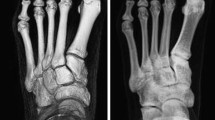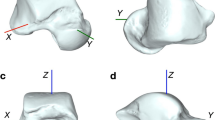Abstract
To quantitatively evaluate the shape of the transverse arch in the forefoot with hallux valgus, a method for axial imaging and analysis of the forefoot has been developed. A foot was imaged at 30° of flexion. A two-dimensional coordinate system was established by drawing a vertical line on the X-ray image through the lowest point of the head of the second metatarsal. The origin was set at the intersection between the plane of the base of the foot and this vertical line. A control group of 51 feet from 29 normal subjects and a test group of 59 feet from 34 subjects with hallux valgus were examined. Compared with the normal group, the heads of the first, second, and third metatarsal bones were lower in the hallux valgus group, and their sesamoids were shifted outward with a rotational deviation. There was a statistical correlation between the degree of outward dislocation of the fibular sesamoid bone and the hallux valgus angle. The position of the fibular sesamoid bone become higher than the head of the first metatarsal when the angle of the hallux valgus exceeded 25°.
Similar content being viewed by others
Author information
Authors and Affiliations
About this article
Cite this article
Suzuki, J., Tanaka, Y., Takaoka, T. et al. Axial radiographic evaluation in hallux valgus: evaluation of the transverse arch in the forefoot. J Orthop Sci 9, 446–451 (2004). https://doi.org/10.1007/s00776-004-0800-9
Received:
Accepted:
Issue Date:
DOI: https://doi.org/10.1007/s00776-004-0800-9




